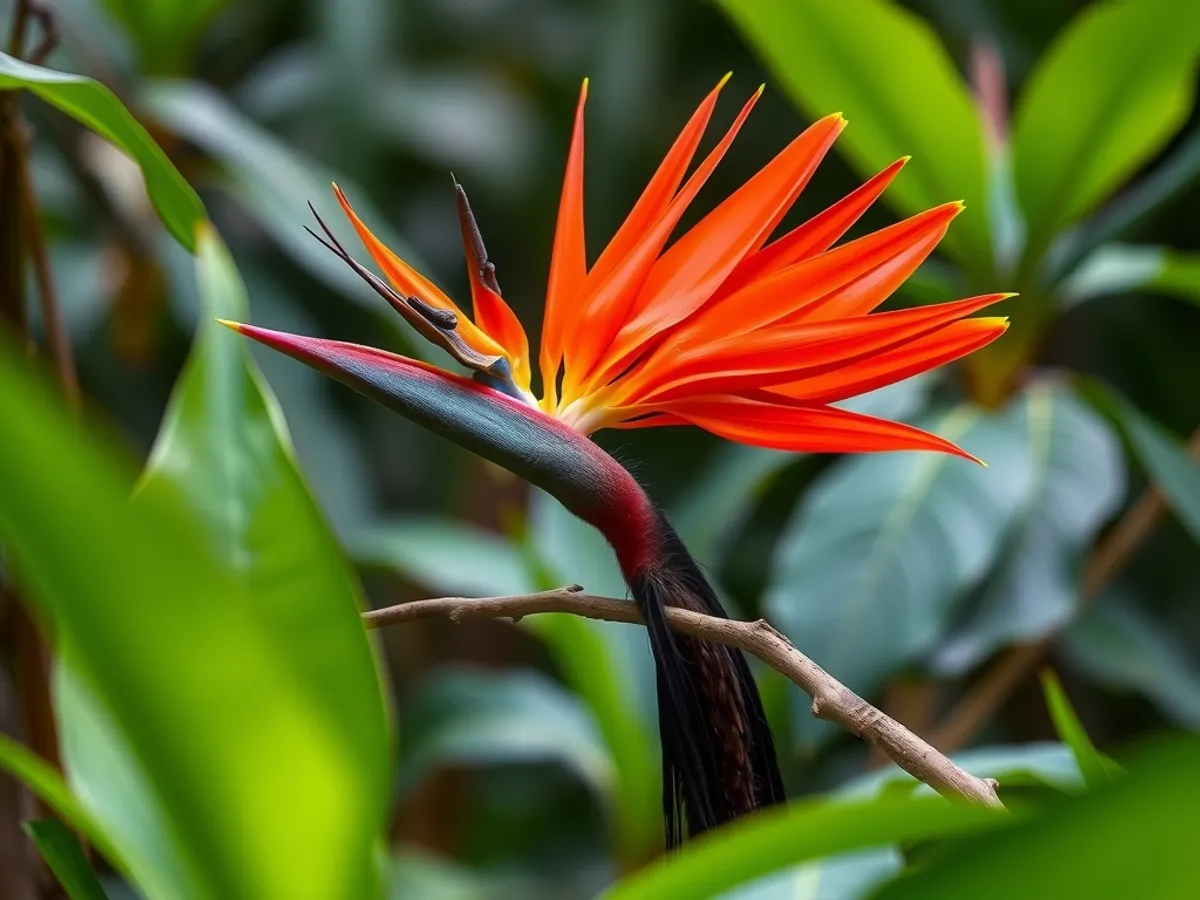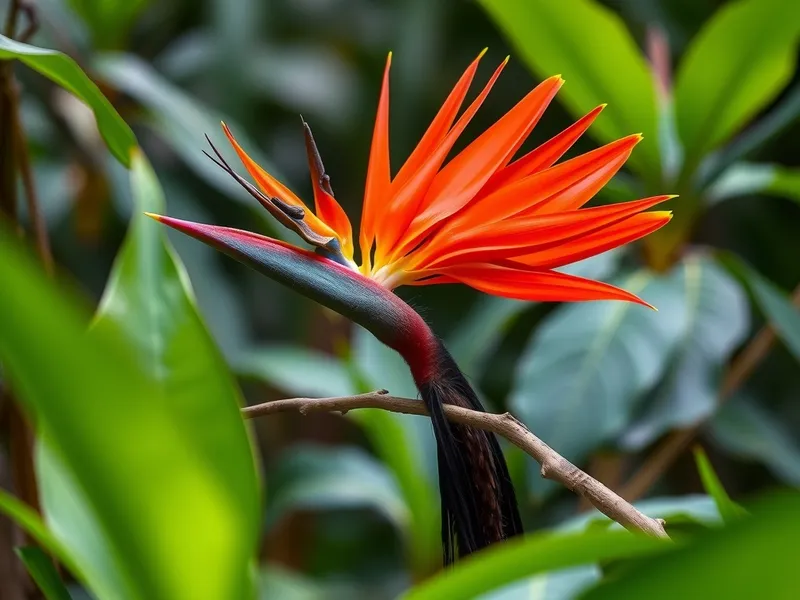
Raggiana Bird-of-paradise
Paradisaea raggiana

Meet the Raggiana Bird-of-paradise
The Raggiana Bird-of-paradise is a striking and flamboyant bird native to the rainforests of New Guinea. Males are renowned for their elaborate courtship displays, featuring vibrant orange-red flank plumes and intricate dance routines performed on communal display perches called leks. These birds primarily feed on fruits, especially figs, but also consume insects and small animals. The species plays a vital ecological role as a seed disperser in its habitat, and its beautiful feathers have long been significant in local cultures.
Classification
Bird
Habitat
Tropical rainforest
Diet
Omnivore
Lifespan
5-8 years
Conservation
Least Concern
Weight
160-240 grams
📖Fascinating Facts
Spectacular Displays
Male Raggiana Birds-of-paradise perform coordinated dances and display their ornate plumes to attract females, often gathering in display trees called leks.
Forest Seed Dispersers
By consuming a variety of fruits and excreting seeds, these birds play a crucial role in maintaining the health and diversity of their rainforest ecosystem.
Symbol of a Nation
The Raggiana Bird-of-paradise is featured on Papua New Guinea's national flag and is a symbol of cultural identity for the country.
📋Detailed Description
The Raggiana Bird-of-paradise (Paradisaea raggiana) is a large passerine bird, measuring approximately 34–36 cm in length, with males sometimes reaching up to 43 cm due to their elongated flank plumes. Adult males are instantly recognizable by their vivid orange to crimson ornamental plumes, which cascade from the flanks and are used in elaborate courtship displays. The head is adorned with a greenish-yellow crown, while the face features a distinctive emerald-green throat patch. Females are less flamboyant, with brownish plumage and shorter tail feathers, providing camouflage while nesting. Both sexes have strong, conical bills adapted for fruit consumption, and robust legs for perching. The species exhibits pronounced sexual dimorphism, with males developing ornate plumage at around 4–6 years of age. Their wings are rounded and relatively short, suited for maneuvering through dense forest canopies. Raggiana Birds-of-paradise are highly vocal, producing a range of mechanical and vocal sounds, including harsh squawks and snapping noises during displays. Their eyes are dark brown, and the feet are grayish-black. The species is endemic to southern and northeastern New Guinea, occupying lowland and mid-montane rainforests up to 1,550 meters in elevation.
💡 Did you know?
Despite their extravagant appearance and popularity, Raggiana Birds-of-paradise remain locally common in much of their range due to their adaptability to different forest types.
🔬Research & Sources
Wikipedia Summary
The Raggiana bird-of-paradise, also known as Count Raggi's bird-of-paradise, is a large bird in the bird-of-paradise family Paradisaeidae.
Last Modified: 5/25/2025
🎭Behavior & Social Structure
Raggiana Birds-of-paradise are primarily frugivorous, foraging in the mid to upper canopy for figs and other fruits, but they also supplement their diet with arthropods, small reptiles, and occasionally nectar. Males are polygynous and highly territorial during the breeding season, gathering at communal display sites known as leks, where they perform synchronized dances, wing claps, and display their vibrant plumes to attract females. Social interactions among males are competitive, with dominant individuals securing the best display perches. Outside the breeding season, the species is generally solitary or found in small, loose groups. They are diurnal, with peak activity in the early morning and late afternoon. Their daily routines involve foraging, preening, and, for males, maintaining their display sites by clearing leaves and debris. Alarm calls are used to warn conspecifics of predators such as raptors and snakes.
👶Reproduction & Life Cycle
Breeding occurs year-round but peaks from July to February, varying regionally with food availability. Males do not participate in nesting or chick rearing. After mating, females build deep, cup-shaped nests from twigs, leaves, and moss, typically 6–12 meters above ground in dense foliage. Clutch size is usually one to two eggs, which are pale cream with brownish markings. The incubation period lasts about 18–20 days, and the female alone incubates and feeds the chicks. Fledging occurs after approximately 20–22 days post-hatching. Juveniles remain with the mother for several weeks before becoming independent. Sexual maturity is reached at about 3–4 years in females and 4–6 years in males, coinciding with the development of adult plumage.
🛡️Adaptations & Survival
The Raggiana Bird-of-paradise exhibits several evolutionary adaptations, including sexually selected ornamental plumage in males for mate attraction, and cryptic coloration in females for nest concealment. Their strong, zygodactyl feet (two toes forward, two backward) allow secure perching on slender branches during displays and foraging. The species has a highly flexible diet, enabling it to exploit seasonal fruit abundance and supplement with animal prey. Their complex vocalizations and mechanical sounds serve both in mate attraction and territory defense. The ability to clear and maintain display courts is a behavioral adaptation that enhances the visibility of their displays and reduces predation risk during vulnerable courtship rituals.
🎨Cultural Significance
The Raggiana Bird-of-paradise holds profound cultural importance in Papua New Guinea, where it is the national bird and features prominently on the national flag and coat of arms. Its feathers have been highly prized in traditional ceremonial dress and as trade items for centuries. The bird is a symbol of beauty, prestige, and connection to the forest, and appears in local myths as a messenger or spirit creature. Community-based conservation initiatives often leverage this cultural reverence to promote habitat protection and sustainable use.
🔬Recent Research & Discoveries
Recent studies have focused on lekking behavior, genetic diversity across regional populations, and the ecological role of the species as a keystone seed disperser. Molecular phylogenetics has clarified relationships within the Paradisaeidae family, revealing complex patterns of hybridization and speciation. Ongoing research is examining the impact of habitat fragmentation on lek stability and reproductive success. Conservation genetics projects are underway to assess gene flow between subpopulations. Behavioral ecologists are also investigating the evolution of display complexity and female mate choice in relation to environmental variables.
🎥Wildlife Videos

20+ Most Gorgeous Birds Of Paradise On Our Planet | Wildlife Documentary | BBTV Official
The dense, ancient rainforests of New Guinea, Australia, and the surrounding islands are home to some of the most extraordinary ...
BBTV Official

Fascinating Colours of the Animal Kingdom | BBC Earth
From a Bowerbird's enticing courtship display to cuttlefish that use camouflage to pursue prey, discover the extraordinary ways ...
BBC Earth

Bird Of Paradise Courtship Spectacle | Planet Earth | BBC Earth
Taken From Planet Earth, Episode 1, Series 1 WATCH MORE: New on Earth: https://bit.ly/2M3La96 Oceanscapes: ...
BBC Earth

Birds of Paradise Mating Dance | Battle of the Sexes | BBC Earth
Taken from 'Battle of the Sexes in the Animal World'. WATCH MORE: New on Earth: https://bit.ly/2M3La96 Oceanscapes: ...
BBC Earth

Bird interrupts David Attenborough | Attenborough's Paradise Birds - BBC
'For me birds of paradise are the most romantic and glamorous birds in the world. And this is a film I have wanted to make for 40 ...
BBC

The Stunning Red Bird of Paradise | Wild Indonesia
About National Geographic Wild: National Geographic Wild is a place for all things animals and for animal-lovers alike. Take a ...
Nat Geo Animals
🌍Habitat Information
The Raggiana Bird-of-paradise typically inhabits Tropical rainforest environments. Raggiana Bird-of-paradises have adapted to their environments with specialized features and behaviors.
Primary Habitat:
Tropical rainforest
More detailed habitat information will be available soon.
🛡️Conservation Status
The Raggiana Bird-of-paradise is currently classified as Least Concern. Conservation efforts are crucial for preserving this species for future generations.
Common Threats:
- 🏠Habitat loss and fragmentation
- 🌡️Climate change impacts
- 🎯Hunting and poaching
- 🏭Human-wildlife conflict
⚠️Threats & Conservation Challenges
Although currently listed as Least Concern by the IUCN, the Raggiana Bird-of-paradise faces ongoing threats from habitat loss due to logging, agricultural expansion, and infrastructure development in New Guinea. Localized hunting for plumes persists, though at reduced levels compared to historical exploitation. Climate change poses a long-term threat by altering fruiting patterns and forest structure. The species remains relatively adaptable, but fragmentation of habitat could lead to isolated populations and reduced genetic diversity. Conservation challenges include monitoring population trends, protecting key lekking and nesting sites, and engaging local communities in sustainable management.
🔬Scientific Classification
Scientific Name
Paradisaea raggiana
Classification Hierarchy
🔍 About Taxonomic Classification
Taxonomic classification is a hierarchical system used by scientists to classify and organize living organisms based on shared characteristics and evolutionary relationships.
The system moves from broad categories (Kingdom) to increasingly specific ones, with each animal's scientific name typically consisting of its Genus and species.
📝Community Notes
Share your observations and insights about the Raggiana Bird-of-paradise with our community of wildlife enthusiasts.
Join Our Community
Sign in to share your observations and connect with fellow wildlife enthusiasts.
Sign In to ContributeNo community notes yet
Be the first to share your observations about the Raggiana Bird-of-paradise!
Explore Raggiana Bird-of-paradise
Select a tab above to learn more about this amazing animal.
📸Photo Gallery
No photos available for this animal yet.
🌟Discover More Wildlife
Continue your journey of discovery with more fascinating animals from our database
